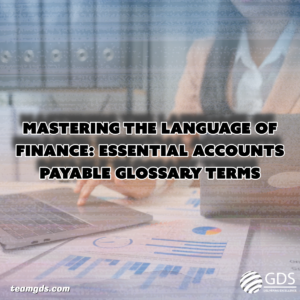The Role of Forecasting in Financial Modeling
The Role of Forecasting in Financial Modeling
Author: GDS
Financial models are an essential tool for making sound business decisions. They allow companies to assess their current financial standing, evaluate future prospects, and make decisions backed by data-driven insights. Understanding the role that forecasting plays in financial modeling is key to creating an accurate and reliable model that can inform important strategic business decisions.
Financial models are an essential tool for making sound business decisions. They allow companies to assess their current financial standing, evaluate future prospects, and make decisions backed by data-driven insights. Understanding the role that forecasting plays in financial modeling is key to creating an accurate and reliable model that can inform important strategic business decisions.
What is Financial Modeling?
Financial modeling is the process of building a model that can be used to assess the current financial standing or evaluate future prospects of a company. It typically involves creating complex calculators in spreadsheets which take into account variables such as revenue, expenses, and costs. The results from these models provide information about likely outcomes based on assumptions from financial forecasts. Business assessments ranging from valuations to credit risk are based on financial models. If you’ve ever built a simple Excel formula to test how changing a variable would affect your revenue, then you have already created a simple financial model of sorts.
Financial models can be used in a variety of situations such as corporate finance, asset pricing, debt structuring, real estate development or equity investments. They can also be used to assess the financial impact of potential decisions such as mergers and acquisitions, forecasting sales trends or deciding on a price for a product. Ultimately, financial models are an essential tool for making sound business decisions.
What is Financial Modeling?
Financial modeling is the process of building a model that can be used to assess the current financial standing or evaluate future prospects of a company. It typically involves creating complex calculators in spreadsheets which take into account variables such as revenue, expenses, and costs. The results from these models provide information about likely outcomes based on assumptions from financial forecasts. Business assessments ranging from valuations to credit risk are based on financial models. If you’ve ever built a simple Excel formula to test how changing a variable would affect your revenue, then you have already created a simple financial model of sorts.
Financial models can be used in a variety of situations such as corporate finance, asset pricing, debt structuring, real estate development or equity investments. They can also be used to assess the financial impact of potential decisions such as mergers and acquisitions, forecasting sales trends or deciding on a price for a product. Ultimately, financial models are an essential tool for making sound business decisions.
The Role of Forecasting in Financial Modeling
Forecasting plays an important role in financial modeling. A good financial model must accurately reflect the assumptions about the future, as it is these assumptions that will drive the business decisions made by companies. Forecasted inputs such as sales, expenses, or capital investments are essential for creating a solid foundation upon which to base decision-making processes.
The forecasting process involves gathering data and trends that are applicable to the current business situation, as well as making assumptions about future trends. This forecasted information is then combined with financial statements and other data to create a model which can be used to assess the company’s current financial standing or evaluate their future prospects.
The Role of Forecasting in Financial Modeling
Forecasting plays an important role in financial modeling. A good financial model must accurately reflect the assumptions about the future, as it is these assumptions that will drive the business decisions made by companies. Forecasted inputs such as sales, expenses, or capital investments are essential for creating a solid foundation upon which to base decision-making processes.
The forecasting process involves gathering data and trends that are applicable to the current business situation, as well as making assumptions about future trends. This forecasted information is then combined with financial statements and other data to create a model which can be used to assess the company’s current financial standing or evaluate their future prospects.
Benefits of Accurate Forecasting
Accurate forecasting is essential for creating a financial model that will provide sound business decisions. Forecasting helps companies accurately anticipate future trends, and this information can be used to make more informed decisions about investment strategies, pricing policies, and other aspects of the business. Accurate forecasting allows organizations to minimize risk by identifying potential threats before they become costly mistakes.
Forecasting also helps companies keep their financial models up to date with the most relevant data. By considering changes in market conditions, economic trends, and other external factors, companies can adjust their assumptions and fine-tune their financial model accordingly. This allows the model to remain as realistic as possible and provide reliable forecasts of potential outcomes.
- Helps companies make more informed decisions about investment strategies, pricing policies, and other aspects of the business.
- Minimizes risk by identifying potential threats before they become costly mistakes.
- Provides reliable forecasts of potential outcomes based on current data and assumptions.
- Gives organizations a better understanding of their financial position and prospects.
- Provides insights into financial trends and potential opportunities.
- Allows companies to adjust their model in order to remain as realistic as possible.
Benefits of Accurate Forecasting
Accurate forecasting is essential for creating a financial model that will provide sound business decisions. Forecasting helps companies accurately anticipate future trends, and this information can be used to make more informed decisions about investment strategies, pricing policies, and other aspects of the business. Accurate forecasting allows organizations to minimize risk by identifying potential threats before they become costly mistakes.
Forecasting also helps companies keep their financial models up to date with the most relevant data. By considering changes in market conditions, economic trends, and other external factors, companies can adjust their assumptions and fine-tune their financial model accordingly. This allows the model to remain as realistic as possible and provide reliable forecasts of potential outcomes.
- Helps companies make more informed decisions about investment strategies, pricing policies, and other aspects of the business.
- Minimizes risk by identifying potential threats before they become costly mistakes.
- Provides reliable forecasts of potential outcomes based on current data and assumptions.
- Gives organizations a better understanding of their financial position and prospects.
- Provides insights into financial trends and potential opportunities.
- Allows companies to adjust their model in order to remain as realistic as possible.
Challenges of Financial Modeling
Financial modeling can be a complex and challenging task. From data collection to results interpretation, creating an effective financial model requires significant resources in terms of time and money. The accuracy of forecasts depends heavily on the assumptions used in the model. If assumptions are inaccurate or outdated, then the resulting forecast may not reflect reality.
Although financial models can provide valuable insights, organizations must be aware of their limitations. Forecasts will only be as accurate as the assumptions used to generate them, and no model can account for all possible factors that may affect the outcome. Because of their complexity, financial models can be difficult to understand or interpret without a strong financial background. As such, organizations should take the necessary steps to ensure that any financial model they use is reliable and properly understood.
- High cost of creating a financial model
- Difficulty in collecting data necessary for accurate forecasts
- Outdated assumptions leading to inaccurate results
- Risk of misinterpretation without a strong financial background
- Complexity of the models making them difficult to understand and interpret
- Inability to account for all factors affecting the outcome
Challenges of Financial Modeling
Financial modeling can be a complex and challenging task. From data collection to results interpretation, creating an effective financial model requires significant resources in terms of time and money. The accuracy of forecasts depends heavily on the assumptions used in the model. If assumptions are inaccurate or outdated, then the resulting forecast may not reflect reality.
Although financial models can provide valuable insights, organizations must be aware of their limitations. Forecasts will only be as accurate as the assumptions used to generate them, and no model can account for all possible factors that may affect the outcome. Because of their complexity, financial models can be difficult to understand or interpret without a strong financial background. As such, organizations should take the necessary steps to ensure that any financial model they use is reliable and properly understood.
- High cost of creating a financial model
- Difficulty in collecting data necessary for accurate forecasts
- Outdated assumptions leading to inaccurate results
- Risk of misinterpretation without a strong financial background
- Complexity of the models making them difficult to understand and interpret
- Inability to account for all factors affecting the outcome
How to Improve Your Forecasting Accuracy
When utilizing financial models for forecasting, businesses can take several steps to increase the accuracy of their forecasts. First and foremost, organizations should ensure that they have access to reliable data sources, as inaccurate information could lead to incorrect results. Businesses should regularly update assumptions used in the model based on changing conditions in their industry or marketplace. Finally, it is important that any financial model is properly understood by those utilizing it, as misinterpretation can lead to inaccurate results. By taking the necessary steps to ensure accurate data and up-to-date assumptions, organizations will be able to develop more reliable forecasts using financial models.
How to Improve Your Forecasting Accuracy
When utilizing financial models for forecasting, businesses can take several steps to increase the accuracy of their forecasts. First and foremost, organizations should ensure that they have access to reliable data sources, as inaccurate information could lead to incorrect results. Businesses should regularly update assumptions used in the model based on changing conditions in their industry or marketplace. Finally, it is important that any financial model is properly understood by those utilizing it, as misinterpretation can lead to inaccurate results. By taking the necessary steps to ensure accurate data and up-to-date assumptions, organizations will be able to develop more reliable forecasts using financial models.
Conclusion
Overall, financial models are an important tool for businesses to create accurate forecasts. By ensuring access to reliable data sources, regularly updating assumptions in the model, and properly understanding the model’s output, organizations can develop more dependable results to inform their decision-making process. With careful planning and consideration of these factors, businesses can more effectively leverage financial models to make informed decisions about their future.
Conclusion
Overall, financial models are an important tool for businesses to create accurate forecasts. By ensuring access to reliable data sources, regularly updating assumptions in the model, and properly understanding the model’s output, organizations can develop more dependable results to inform their decision-making process. With careful planning and consideration of these factors, businesses can more effectively leverage financial models to make informed decisions about their future.
GDS ONSIGHT- A Field Service & Delivery Application
If you’re interested in leveraging financial models to make better-informed decisions for your business, contact us today to learn more about how our team of experts can help.
GDS ONSIGHT- A Field Service & Delivery Application
If you’re interested in leveraging financial models to make better-informed decisions for your business, contact us today to learn more about how our team of experts can help.








